 Kumano, a land of seafarers, has several
festivals held on or near the sea. This festival is one
example and is held on Oshima Island, near Kushimoto
Town. This festival is held on February 11th under the
direction of the Oshima l Shrine. The main deity of
the shrine is 'Homutawakenomikoto' (Emperor Ojin) who
fled from a historic rebellion and came to the shores of
Oshima Island which was guarded by Takenouchinosukune.
The island people warmly welcomed him by sending boats
out to meet him. This is the origin of the festival. Its
highlight is 'kaitenma kyoso' where two boats race from
Oshima Island to the town of Kushimoto.
Kumano, a land of seafarers, has several
festivals held on or near the sea. This festival is one
example and is held on Oshima Island, near Kushimoto
Town. This festival is held on February 11th under the
direction of the Oshima l Shrine. The main deity of
the shrine is 'Homutawakenomikoto' (Emperor Ojin) who
fled from a historic rebellion and came to the shores of
Oshima Island which was guarded by Takenouchinosukune.
The island people warmly welcomed him by sending boats
out to meet him. This is the origin of the festival. Its
highlight is 'kaitenma kyoso' where two boats race from
Oshima Island to the town of Kushimoto. to the top
 This
festival, called Maruyama Senmaida, is held in Kiwa Town
in an area which still features 2200 terraced rice
paddies. This can be said to be an archetypical landscape
of the Kumano mountain people. This festival is an
expression of the local wisdom which emphasizes the
importance of living in harmonious coexistence with
nature. This festival is held right in the rice paddies.
The dance is a prayer calling for a good harvest through
sharing the grace of nature by working in harmony with
its laws. The festival continues to be preserved by the
Kiwa Town Local Performing Arts Preservation Society.
This
festival, called Maruyama Senmaida, is held in Kiwa Town
in an area which still features 2200 terraced rice
paddies. This can be said to be an archetypical landscape
of the Kumano mountain people. This festival is an
expression of the local wisdom which emphasizes the
importance of living in harmonious coexistence with
nature. This festival is held right in the rice paddies.
The dance is a prayer calling for a good harvest through
sharing the grace of nature by working in harmony with
its laws. The festival continues to be preserved by the
Kiwa Town Local Performing Arts Preservation Society. to the top
 This is a festival held under the auspices of
the Hayatama Grand Shrine. Its outstanding feature is the
boat race held on the Kumano River. This is the finale of
the Kumano Hayatama Grand Shrine Festival, held on
October 15 and 16. The nine racing boats are from the
nine wards of 'Old Shingu'. To prepare for this race the
teams engage in hard training for more than one month.
This is a festival held under the auspices of
the Hayatama Grand Shrine. Its outstanding feature is the
boat race held on the Kumano River. This is the finale of
the Kumano Hayatama Grand Shrine Festival, held on
October 15 and 16. The nine racing boats are from the
nine wards of 'Old Shingu'. To prepare for this race the
teams engage in hard training for more than one month. 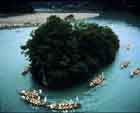 Nine racing boats lead the beautiful Shinkosen
boat which carries a portable shrine pulled by another
boat called the Morotesen. This festival is not only a
boat race but also has to do with the resurrection of the
Hayatama Grand Deity. The race begins on the riverbank
downstream from the shrine. The rowers set out for an
island in the river which is about 1km away. Each boat
must circle the island, and the first boat to return to
the starting point wins a special prize. This photo
conjures up memories of the old Kumano Navy of ancient
times.
Nine racing boats lead the beautiful Shinkosen
boat which carries a portable shrine pulled by another
boat called the Morotesen. This festival is not only a
boat race but also has to do with the resurrection of the
Hayatama Grand Deity. The race begins on the riverbank
downstream from the shrine. The rowers set out for an
island in the river which is about 1km away. Each boat
must circle the island, and the first boat to return to
the starting point wins a special prize. This photo
conjures up memories of the old Kumano Navy of ancient
times.
to the top
 On
the first of December each year a festival is held at the
Konoha Shrine in Koza Town which commemorates the day
when Empress Jingu gave birth there to a child. Early in
the morning, the priest starts Shinto rites carrying a
rolled straw mat and something which resembles a mother's
breasts. A beautiful ten year old girl is chosen to
perform the Shinto rite as a rice carrier holding a
wooden rice bucket on her head. Afterwards other
ceremonies are performed, i.e. a bow and arrow ceremony,
a question and answer session about oranges. Each of
these ceremonies has a deep cultural significance. The Nenneko Festival is considered to be an 'Intangible
Cultural Treasure' by the Wakayama Prefecture Government.
On
the first of December each year a festival is held at the
Konoha Shrine in Koza Town which commemorates the day
when Empress Jingu gave birth there to a child. Early in
the morning, the priest starts Shinto rites carrying a
rolled straw mat and something which resembles a mother's
breasts. A beautiful ten year old girl is chosen to
perform the Shinto rite as a rice carrier holding a
wooden rice bucket on her head. Afterwards other
ceremonies are performed, i.e. a bow and arrow ceremony,
a question and answer session about oranges. Each of
these ceremonies has a deep cultural significance. The Nenneko Festival is considered to be an 'Intangible
Cultural Treasure' by the Wakayama Prefecture Government.
to the top
 Katsuura Town has been a thriving port for many
years and recently has become a major centre for tuna
fishing in the Kinki Region of Japan. Deep in the harbour
of Katsuura Town the Katsuura Hachiman Shrine can be
found. Each year on September 15 the shrine holds a major
festival which features an exciting boat race. After a
Shinto ceremony, the boats, powered by several strong
young men in loincloths and bandanas, race across
Katsuura Bay just in front of the fish market.
Katsuura Town has been a thriving port for many
years and recently has become a major centre for tuna
fishing in the Kinki Region of Japan. Deep in the harbour
of Katsuura Town the Katsuura Hachiman Shrine can be
found. Each year on September 15 the shrine holds a major
festival which features an exciting boat race. After a
Shinto ceremony, the boats, powered by several strong
young men in loincloths and bandanas, race across
Katsuura Bay just in front of the fish market. to the top
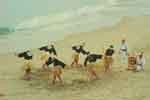 This
dance is one of the local performing arts of Kumano
Sansho Omiwa Yashiro Shrine (Nagisa no miya) in
Hamanomiya, Nachi Katsuura Town. This is thought to be
one of the 'big catch' dances which can be seen all over
Japan. But its graceful hand movements are said to set
this dance apart from the rest. The dancers wear a head
band and a hemp palm loincloth and dance to flute and
drum music.
This
dance is one of the local performing arts of Kumano
Sansho Omiwa Yashiro Shrine (Nagisa no miya) in
Hamanomiya, Nachi Katsuura Town. This is thought to be
one of the 'big catch' dances which can be seen all over
Japan. But its graceful hand movements are said to set
this dance apart from the rest. The dancers wear a head
band and a hemp palm loincloth and dance to flute and
drum music. to the top
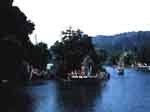 This is a unique festival held in Koza Town from
July 23 to 25. Held at the mouth of Koza River it is a
festival which is based on the indigenous belief that
farming and fishing are interdependent.
This is a unique festival held in Koza Town from
July 23 to 25. Held at the mouth of Koza River it is a
festival which is based on the indigenous belief that
farming and fishing are interdependent. 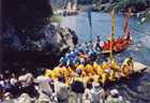 Early
on the morning of July 23rd the festival begins by
drawing water from the sea below the Koza Shrine in order
to begin the rites of purification for all households in
Koza. On the 24th, various singing and chanting rituals
are performed in honour of important figures in Japanese
mythology. On the 25th, the festival proper begins, along
with a boat race in memory of the ancient Kumano Navy
which was once based here. The method of rowing the boats
is a legacy from the whaling era in the region. The
festival ends with a special ceremony involving the
boats.
Early
on the morning of July 23rd the festival begins by
drawing water from the sea below the Koza Shrine in order
to begin the rites of purification for all households in
Koza. On the 24th, various singing and chanting rituals
are performed in honour of important figures in Japanese
mythology. On the 25th, the festival proper begins, along
with a boat race in memory of the ancient Kumano Navy
which was once based here. The method of rowing the boats
is a legacy from the whaling era in the region. The
festival ends with a special ceremony involving the
boats.
to the top
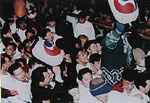 This festival is held every February under the
direction of the Owase Shrine. It is sometimes called the
'Hadaka Matsuri (Naked Festival)', but usually is known
as the 'Yaaya Matsuri' due to the shouting of the young
festival participants walking throughout the town. This
festival is held under the direction of the Owase Shrine
also known as the 'Hadaka Matsuri (Naked Festival)'.
After a Shinto ceremony three Shinto priests who have
been selected to perform this year's ceremonies walk
through the town with generals, ladies of the court,
portable shrines, and a parade. The younger participants
guard the parade shouting 'Yaaya' and jostle fiercely
against one another, full of the vigour characteristic of
seamen.
This festival is held every February under the
direction of the Owase Shrine. It is sometimes called the
'Hadaka Matsuri (Naked Festival)', but usually is known
as the 'Yaaya Matsuri' due to the shouting of the young
festival participants walking throughout the town. This
festival is held under the direction of the Owase Shrine
also known as the 'Hadaka Matsuri (Naked Festival)'.
After a Shinto ceremony three Shinto priests who have
been selected to perform this year's ceremonies walk
through the town with generals, ladies of the court,
portable shrines, and a parade. The younger participants
guard the parade shouting 'Yaaya' and jostle fiercely
against one another, full of the vigour characteristic of
seamen. to the top
 On the 15th of April every year there
is a festival in which people in traditional attire walk in procession
from the new shrine to Oyunohara@in the full broom of cherry.
On the 15th of April every year there
is a festival in which people in traditional attire walk in procession
from the new shrine to Oyunohara@in the full broom of cherry.
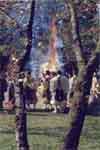 This is the original site of the
Hongu Grand Shrine. It is located on a small forested island where the
Kumano River and Otonashi River meet. The old shrine was washed away by a
flood in 1889. Moss-covered foundation stones and a stone wall still
remain and people often come to enjoy the cherry blossoms in spring or the
changing of the leaves in the autumn.
This is the original site of the
Hongu Grand Shrine. It is located on a small forested island where the
Kumano River and Otonashi River meet. The old shrine was washed away by a
flood in 1889. Moss-covered foundation stones and a stone wall still
remain and people often come to enjoy the cherry blossoms in spring or the
changing of the leaves in the autumn.
to the top